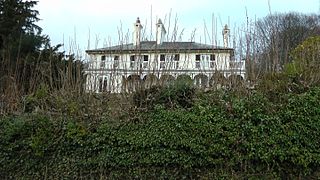
Llangollen is a town and community, situated on the River Dee, in Denbighshire, Wales. Its riverside location forms the edge of the Berwyn range, and the Dee Valley section of the Clwydian Range and Dee Valley Area of Outstanding Natural Beauty, with the easternmost point of the Dee Valley Way being within the town. It had a population of 3,658 at the 2011 census.

The Ellesmere Canal was a waterway in England and Wales that was planned to carry boat traffic between the rivers Mersey and Severn. The proposal would create a link between the Port of Liverpool and the mineral industries in north east Wales and the manufacturing centres in the West Midlands. However, the canal was never completed as intended because of its rising costs and failure to generate the expected commercial traffic.
The Great Western Railway Hawthorn Class were 2-4-0 broad gauge steam locomotives for passenger train work. This class was introduced into service in 1865, a development of the Victoria Class.

Charles Frederick Beyer was a celebrated German-British locomotive designer and builder, and co-founder of the Institution of Mechanical Engineers. He was the co-founder and head engineer of Beyer, Peacock and Company in Gorton, Manchester. A philanthropist and deeply religious, he founded three parish churches in Gorton, was a governor of The Manchester Grammar School, and remains the single biggest donor to what is today the University of Manchester. He is buried in the graveyard of Llantysilio Church, Llantysilio, Llangollen, Denbighshire North Wales. Llantysilio Church is within the grounds of his former 700 acre Llantysilio Hall estate. His mansion house, built 1872–1874, is nearby.
Beyer, Peacock and Company was an English railway locomotive manufacturer with a factory in Openshaw, Manchester. Founded by Charles Beyer, Richard Peacock and Henry Robertson, it traded from 1854 until 1966. The company exported locomotives, and machine tools to service them, throughout the world.

The Buckley Railway was opened from Buckley to a connection with the Chester to Holyhead main line on 7 June 1862, to convey coal and finished brickworks products from the Buckley area. Numerous short tramroads had existed in the area from the 1700s. The line was steeply graded and sharply curved.

Richard Peacock was an English engineer, one of the founders of locomotive manufacturer Beyer, Peacock and Company.

The Brymbo Steel Works was a former large steelworks in the village of Brymbo near Wrexham, Wales. In operation between 1796 and 1990, it was significant on account of its founder, one of whose original blast furnace stacks remains on the site.

The SLNCR Lough Class was a class of 0-6-4T steam tank locomotives of the Sligo, Leitrim and Northern Counties Railway (SLNCR).

The GS&WR Class 101, classified as Class 101 or Class J15 by the Great Southern Railways, was a class of 0-6-0 steam locomotives designed for working goods traffic although they did, and were quite capable of, working branch and secondary passenger trains.

Llandderfel railway station in Gwynedd, Wales, was a station on the Ruabon to Barmouth line. It closed to passengers ahead of the scheduled closure date of Monday 18 January 1965 because of flooding by the River Dee which breached the line near Llandderfel on 14 December 1964. This section of the line was never re-opened. The station had a signal box and was a passing place on the single line. Today, no trace of the station buildings exist; however, the flight of steps that leads from the road overbridge down to where the platforms once were are still in situ, along with a small section of overgrown "up" platform a few yards up from the steps.
The Beyer Chair of Applied Mathematics is an endowed professorial position in the Department of Mathematics, University of Manchester, England. The endowment came from the will of the celebrated locomotive designer and founder of locomotive builder Beyer, Peacock & Company, Charles Frederick Beyer. He was the university's largest single donor.

Henry Robertson was a Scottish mining engineer and prolific railway builder, industrialist and Liberal Party politician. He was head of Brymbo Steelworks, Wrexham. He was co-founder of Beyer-Peacock, with Charles Beyer, and Richard Peacock. His son Sir Henry Beyer Robertson was knighted by Queen Victoria for the achievements of his father.

The South African Railways Class NG G16 2-6-2+2-6-2 was a narrow gauge steam locomotive.

Llandderfel is a village and a sparsely populated community in Gwynedd, Wales, near Bala, formerly served by the Llandderfel railway station. The community also includes the settlements of Glan-yr-afon, Llanfor, Cefnddwysarn and Frongoch. The Community population taken at the 2011 census was 1,095.

The Chain Bridge is a footbridge over the River Dee at Berwyn, Llangollen, Denbighshire, north Wales.

Llantysilio Church is a parish church in Llantysilio, near Llangollen, Denbighshire, North Wales.
Sir Henry Beyer Robertson was a British industrialist. He was the son of Henry Robertson, of Palé Hall, Llandderfel.

Bryntysilio Hall is a country house in Llantysilio, Denbighshire, north Wales, two miles west of Llangollen. It was the summer residence of Sir Theodore Martin, the author of Life of The Prince Consort, the official biography of Prince Albert, and of his wife, Shakespearean actress Lady Martin. Sir Theodore wrote most of the book whilst at Bryntysilio, which was their summer residence. He was knighted for his work and became a close friend of Queen Victoria. It was written 1874-1880. On 26 August 1889, during Victoria's visit to North Wales, she visited Bryntysilio Hall and took tea there. Sir Theodore showed the queen the writing desk where most of the work was written.
















